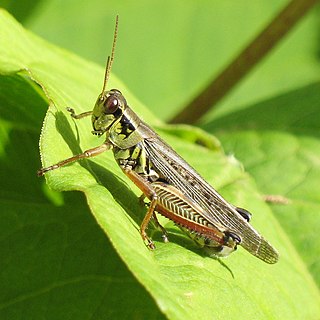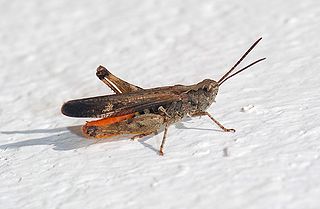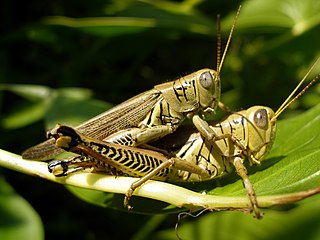Related Research Articles

Eichhornia, commonly called water hyacinths, was a polyphyletic genus of the aquatic flowering plants family Pontederiaceae. Since it was consistently recovered in three independent lineages, it has been sunk into Pontederia, together with Monochoria. Each of the three lineages is currently recognized as subgenera in Pontederia:

Grasshoppers are a group of insects belonging to the suborder Caelifera. They are among what is probably the most ancient living group of chewing herbivorous insects, dating back to the early Triassic around 250 million years ago.

Pontederiaceae is a family of flowering plants.
The mottled water hyacinth weevil, Neochetina eichhorniae, is a beetle that has been introduced as a biological pest control herbivore agent to waterways and lakes in countries worldwide to control the spread of the invasive noxious weed species Eichhornia crassipes, the water hyacinth, an aquatic plant native to the Amazon basin.
Neochetina is a genus of weevils known as water hyacinth weevil which are native to South America.

Melanoplus is a large genus of grasshoppers. They are the typical large grasshoppers in North America. A common name is spur-throat grasshoppers, but this more typically refers to members of the related subfamily Catantopinae.

Pontederia crassipes, commonly known as common water hyacinth, is an aquatic plant native to the Amazon basin, and is often a highly problematic invasive species outside its native range. It is the sole species of Pontederia subg. Oshunae.

Chorthippus brunneus, also known as the common field grasshopper, is a species of grasshopper of the subfamily Gomphocerinae. It was first described by Thunberg in 1815. It is also known as Gryllus brunneus, although this name has not been adopted by the IUCN. The IUCN lists C. brunneus as Least Concern.

The differential grasshopper is a species of grasshopper belonging to the genus Melanoplus. It is found throughout northern Mexico, the central United States and southern Ontario, Canada. It is considered a pest over most of its range.

Taiamã Ecological Station is an ecological station in the Mato Grosso state of Brazil.
Eccritotarsus catarinensis is a species of plant bug from Santa Catarina, Brazil. It is a sap-feeding mirid that removes a considerable amount of chlorophyll from water hyacinth.

The red-legged grasshopper is a species of grasshopper belonging to the genus Melanoplus. It is one of the most common grasshoppers found in Mexico, the United States, and Canada. This grasshopper is frequently used as a model organism in scientific studies, due to their abundance throughout North America and behavioral response to changes in climate.

Dactylotum bicolor, also known as the rainbow grasshopper, painted grasshopper, or the barber pole grasshopper, is a species of grasshopper in the family Acrididae. It is native to the United States, Canada and northern Mexico and exhibits aposematism. It was first described by the German entomologist Toussaint de Charpentier in 1843.

Taeniopoda eques, the western horse lubber grasshopper, is a relatively large grasshopper species of the family Romaleidae found in the arid lower Sonoran life zone of the southwestern United States and northern Mexico. Northern populations are identifiable by their shiny black bodies and black and yellow reticulated forewings. Some southern populations are yellow in the adult stage. The species is unique in using its black coloration to thermoregulate and in being chemically defended. The aposematic coloration warns vertebrate predators of its unpalatability and allows the grasshopper to roost conspicuously upon desert shrubs.

Samea multiplicalis, the salvinia stem-borer moth, is an aquatic moth commonly found in freshwater habitats from the southern United States to Argentina, as well as in Australia where it was introduced in 1981. Salvinia stem-borer moths lay their eggs on water plants like Azolla caroliniana, Pistia stratiotes, and Salvinia rotundifolia. Larval feeding on host plants causes plant death, which makes S. multiplicalis a good candidate for biological control of weedy water plants like Salvinia molesta, an invasive water fern in Australia. However, high rates of parasitism in the moth compromise its ability to effectively control water weeds. S. multiplicalis larvae are a pale yellow to green color, and adults develop tan coloration with darker patterning. The lifespan, from egg to the end of adulthood is typically three to four weeks. The species was first described by Achille Guenée in 1854.

Water hyacinth has become a major invasive plant species in Lake Victoria and while it is native to the continent of South America, human activity has introduced the greenery to Lake Victoria, where it is claimed to have negatively affected local ecosystems.

Limnobium laevigatum is a floating aquatic plant, and is a member of the family Hydrocharitaceae. Common names include West Indian spongeplant, South American spongeplant and Amazon or smooth frogbit. This plant was introduced to North American waterways through use in aquariums and aquascapes.

Schistocerca americana is a species of grasshopper in the family Acrididae known commonly as the American grasshopper and American bird grasshopper. It is native to North America, where it occurs in the eastern United States, Mexico, and the Bahamas. Occasional, localized outbreaks of this grasshopper occur, and it is often referred to as a locust, though it lacks the true swarming form of its congener, the desert locust.

Valanga nigricornis, the Javanese grasshopper, is a species of grasshopper in the subfamily Cyrtacanthacridinae of the family Acrididae. It is found in southeastern Asia, the type location being Singapore. It was first described by the German zoologist Hermann Burmeister in 1838. There are more than twenty subspecies, most of which are endemic to different island groups; the subspecies V. nigricornis nigricornis is the type for the genus Valanga.

Eyprepocnemis plorans, the lamenting grasshopper, is a species of insect in the family Acrididae. It is the type species of the genus Eyprepocnemis, and is found in Africa, parts of the Middle East, and southern Europe. It typically inhabits wetlands and other moist habitats.
References
- ↑ S. Capello; M.L. de Wysiecki; M. Marchese (2011). "Feeding patterns of the aquatic grasshopper Cornops aquaticum (Bruner) (Orthoptera: Acrididae) in the middle Paraná river, Argentina". Neotropical Entomology. 40 (2): 170–175.
- 1 2 Joachim Adis; Carlos F. Sperber; Edward G. Brede; Soledad Capello; Maria Celeste Franceschini; Martin Hill; Marcos G. Lhano; Marinê. A; M. Marques; Ana L. Nunes; Perry Polar (2008). "Morphometric differences in the grasshopper Cornops aquaticum (Bruner, 1906) from South America and South Africa". Journal of Orthoptera Research. 17 (2): 141–147. doi:10.1665/1082-6467-17.2.141. hdl: 11336/38330 .
- ↑ James H. Thorp; D. Christopher Rogers, eds. (2015). Thorp and Covich's Freshwater Invertebrates: Ecology and General Biology. I (4th ed.). Elsevier. p. 1070. ISBN 978-0-12-385026-3.
- 1 2 3 4 5 6 7 Lin Besaans (2011). Cornops aquaticum . Plant Protection Research Institute, Department of the Environment (South Africa). Accessdate 17 March 2019.
- 1 2 Ferreira, S.A.; J. Vasconcellos-Neto (2001). "Host Plants of the Grasshopper Cornops aquaticum (Bruner) (Orthoptera: Acrididae) in the Wetland of Poconé, MT, Brazil". Neotrop. Entomol. 30 (4): 523–533. doi: 10.1590/S1519-566X2001000400003 .
- ↑ Charles W. Heckman (1998). The Pantanal of Poconé: Biota and Ecology in the Northern Section of the World's Largest Pristine Wetland. Springer Science & Business Media. p. 249. ISBN 978-94-017-3423-3.
- 1 2 3 4 5 Hill, M.P.; Oberholzer, I.G. (2000). "Host Specificity of the Grasshopper, Cornops aquaticum, a Natural Enemy of Water Hyacinth" (PDF). Proceedings of the X International Symposium on Biological Control of Weeds: 349–356.
- ↑ Franceschini, M.C.; De Wysiecki, M.L.; Poi de Neiff, A.; Galassi, M.E.; Martínez, Fedra S. (2011). "The role of the host-specific grasshopper Cornops aquaticum (Orthoptera: Acrididae) as consumer of native Eichhornia crassipes (Pontederiaceae) floating meadows". Revista de Biología Tropical. 59 (3): 1407–1418. PMID 22017141.
- ↑ Balian, E.V.; Lévêque, C.; Segers, H.; Martens, K. (2008). Freshwater Animal Diversity Assessment. Springer Science & Business Media. p. 542. ISBN 978-1-4020-8259-7.
- ↑ Franceschini, Celeste; Martínez, F. Solange; De Wysiecki, M. Laura (2014). "Performance and Feeding Preference of Cornops aquaticum (Orthoptera: Acrididae) on Eichhornia crassipes and Crop Plants in Native Area". Journal of Orthoptera Research. 83–90 (2): 83–90. doi:10.1665/034.023.0203. hdl: 11336/25666 .